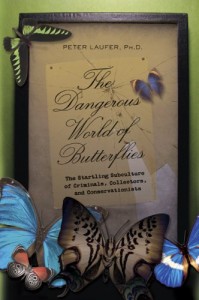Archive for April, 2010
Book-posts That Caught My Eye
- Sick with longing for it – “it took about 7 pages to realize I was reading something not lofty and poetic but actually beautiful, but about 70 pages to realize that this book was just what I needed. It’s The Winter Vault, by Anne Michaels. And in it I found a much-needed oasis of stillness amid my otherwise chaotic life and frenzied reading habits of late. “
- Russian Lit – “All because of The Possessed: Adventures with Russian Books and the People Who Read Them, by Elif Batuman. “
- Times two – Yay! News of the sequel to Sweetness at the Bottom of the Pie.
Comments are off
Graffiti for Butterflies
Another tidbit from The Dangerous World of Butterflies:
[Elliot Malkin of Brooklyn, NY] worries that migrating Monarch butterflies, in search of their plant food milkweed, will find a dearth of the needed vegetation in the urban reaches of New York City. Intent to do what he can to help, he placed potted milkweed plants on the balcony of his apartment. Concerned that it might be difficult for the butterflies to locate his few plants in the asphalt jungle, two ideas came to him: paint giant pictures of milkweed adjacent to the real plants to alert the flying Monarchs, and then paint them with sunblock.
“Milkweed flowers,” says Malkin, “have natural ultraviolet patterns that are recognizable to Monarch butterflies. These patterns are invisible to us because we can’t see light in the ultraviolet spectrum. So Graffiti for Butterflies uses sunblock to pain the graffiti in a way that mimics these natural ultraviolet properties.” Sunblock is a perfect medium, he says, because it reflects ultraviolet light. Malkin considers his work “the equivalent of a fast-food sign on a highway, advertising rest stops to Monarchs.”
Malkin can’t say conclusively whether his sunblocked paintings are responsible for attracting the butterflies to his rooftop garden, but they are indeed visiting his milkweed plants. Here’s Malkin’s website.
In other news, our milkweed is blooming.
(Photo of last year’s crop.)
Nonfiction for Teens
Books my 14-year-old has enjoyed in recent months (and me, too, many of them):
The Dangerous World of Butterflies: The Startling Subculture of Criminals, Collectors, and Conservationists by Peter Laufer. My first-half-of-the-book notes here. (Edited to add, now that I’ve finished the book: there is a bit of, erm, mature content in the chapter about convicted butterfly smuggler Yoshi Kojima. Parents of younger readers may want to preview that bit.)
Fruitless Fall: The Collapse of the Honey Bee and the Coming Agricultural Crisis by Rowan Jacobsen. Posts here and here.
Also by Rowan Jacobsen, Chocolate Unwrapped: The Surprising Health Benefits of America’s Favorite Passion. My MFA classmate was ahead of the wave on the “chocolate is health food” news. This slim little book packs a ton of information in Rowan’s typically engaging style, delving into the science behind these glad tidings. My thoughts here.
(We are keen to read his latest work, American Terroir: Savoring the Flavors of our Woods, Waters, and Fields—”Why does honey from the tupelo-lined banks of the Apalachicola River have a kick of cinnamon unlike any other? Why is king salmon from Alaska’s Yukon River the richest in the world? Why do coffee beans from a single estate in Panama sell at auction for ten times the price of any other beans in the world? The reason is terroir, the ‘taste of place.’” His shellfish and shorelines book looks interesting, too.)
Of a Feather: A Brief History of American Birding by Scott Weidensaul. I heard about this one at Mental Multi-vitamin and knew both Jane and I would enjoy it. I read a few early passages out loud, and Jane recalled reading about Alexander Wilson’s woodpecker misadventure in Muse magazine some time earlier. She took over Of a Feather and thoroughly enjoyed it.
Don’t Know Much about History
Don’t Know Much about Geography
Don’t Know Much about the Universe, all by Kenneth C. Davis
Microbe Hunters by Paul de Kruif, about the discovery of microbes and their role in the transmission of disease.
Charles and Emma: The Darwins’ Leap of Faith by Deborah Heiligman. Although I was a little disappointed in the depiction of Emma Darwin’s religious conviction—it seemed more like a salve deliberately applied to soothe grief than an authentic, considered belief system, which is at odds with the sharp intelligence and probing powers of examination we see in Emma’s letters—I really liked this book about the Darwins’ marriage and the development of Charles’s ideas. Deborah Heiligman’s affection and respect for both Charles and Emma is shiningly apparent. I was surprised to learn what a doting teddy-bear of a father Charles was, and I loved reading his letters and journal writings which are overflowing with expressions of his deep love and admiration for his wife. Jane remarked upon how interesting she found their relationship, how they made it work despite differences of belief. Yes, that resonated with me too. 😉
This week’s Nonfiction Monday roundup can be found at Lerner Books.
Booknotes: The Dangerous World of Butterflies
 The Dangerous World of Butterflies: The Startling Subculture of Criminals, Collectors, and Conservationists by Peter Laufer. Lyons Press, 2009.
The Dangerous World of Butterflies: The Startling Subculture of Criminals, Collectors, and Conservationists by Peter Laufer. Lyons Press, 2009.
We heard about it from our friend Sarah (this Sarah), who correctly supposed it might be interesting to Jane and me. Jane read it first and loved it. Of course, her fascination with butterflies goes way back. I’m about a third of the way through the book and had to stop and jot down some notes. It’s that kind of read. (My favorite kind.)
Peter Laufer is a journalist and the author of several books about serious, even grim topics: Americans in overseas prisons, immigration, the Iraq War. During a Q-and-A period following the publication of his book on the latter, someone asked him what topic he was going to tackle next. Joking, Laufer suggested he might take a break with something less weighty: “butterflies and flowers,” perhaps.
An American ex-pat in Nicaragua saw the exchange on CSPAN and emailed Laufer an invitation to visit her butterfly reserve; she thought it might be a peaceful respite for him. And thus it came about that Laufer’s lighthearted remark became reality: he became interested in butterflies and the lively subcultures they have inspired—the collectors, the breeders, the “butterfly huggers,” even butterfly smugglers.
A few quotes:
Heading down the mountain [after a butterfly-spotting hike] I realize I’ve gone native to a certain extent. It was exactly what Glassberg suggested it would be: a Zen-like moment in the now. Nothing else was going on for me while I was searching for the Golden Hairstreak and spotting the California Sister. There was something pure about not chasing them with a net, just searching and observing. It reminded me of the license plate game my sister and I played while driving with my family across America. Look! There’s one from North Dakota! Rare is valuable, but not vital. If you’re in North Dakota, there’s another and another. But the sightings still can amuse those of us lucky enough to be in touch with the childlike parts of our minds.
The excitement was real. It was impossible not to be seduced by the focus of the moment, the pristine beauty of the rushing Cedar Creek with its towering pines and the burly oaks. The satisfaction of seeing the fluttering rare Golden Hairstreak and the glamorous common California Sister was real. I was an observer in this odd subculture but at the same time an active player delighting in the moment, not just observing as a news reporter.
Another passage quotes a Robert Graves poem:
The erratic-looking flight of the common Cabbage White butterfly can be attributed in part to buffeting from the wind. However, Professor Dudley [of Berkeley] says when researchers fly Cabbage Whites in still air, the erratic patterns do not disappear and are used for defense. “If you swing a net at them and miss, they’ll start doing it faster. That’s an intriguing feature that distinguishes butterflies essentially from all other flying insects, the high degree of erratic, seemingly unpredictable flight.”
That lack of predictable pattern adds to their aesthetic appeal to us, he and I agree, and inspired Robert Graves when he wrote his ode to the Cabbage White, the poem “Flying Crooked…”
And here’s that:
Flying Crooked
by Robert GravesThe butterfly, a cabbage-white,
(His honest idiocy of flight)
Will never now, it is too late,
Master the art of flying straight,
Yet has—who knows so well as I?—
A just sense of how not to fly:
He lurches here and here by guess
And God and hope and hopelessness.
Even the acrobatic swift
Has not his flying-crooked gift.
Here’s something I did not know:
Inside the hard chrysalis the transformation is in progress. “All of their body parts, every cell, liquefies.” It is, as [biologist Rachel Diaz-Bastin] said before, science fiction. “This is weird stuff. All of their cells differentiate and begin forming the adult butterfly. It’s basically this big butterfly soup inside.”
Were you to cut the chrysalis at this stage, you would find nothing resembling a caterpillar and nothing resembling a butterfly: only liquid…What exactly goes on in the soup to make the change remains an unknown to scientists…
Only LIQUID, seriously? Who knew! I think I’d always supposed it was more of a tadpole-to-frog gradual transformation.
That’s as far as I’ve gotten. More to come, I’m sure.
Related posts:
Butterflies, or: the benefits of strewing
“A little egg lay on a leaf”
Our backyard gave us a going-away present
The tragic tale of Homer the Caterpillar, parts one and two
Advice Taken
After I read Steve Bragaw’s review of Prince of Thieves by Chuck Hogan, I went straight to the library website to reserve a copy. And got a big fat REQUEST DENIED message, which befuddled me until I saw the fine print: “A copy has already been reserved for this account.”
But of course. Scott beat me to it.
Here’s how Steve hooked me (and, evidently, my husband):
…an amazing read. One of those books where you pick it up and say to yourself you’ll read a bit, and the next thing you know it’s 330 in the morning, your eyes are killing you, but you have to read just one more page to find out what happens.
Had me at “next thing you know.”
Comments are off


